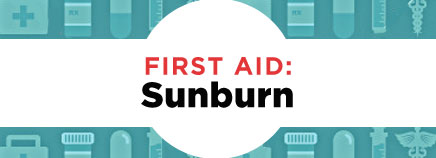
Sunburn can happen within 15 minutes of being in the sun, but the redness and discomfort may not be noticed for a few hours. Repeated sunburns can lead to skin cancer. Unprotected sun exposure is even more dangerous for kids who have many moles or freckles, very fair skin and hair, or a family history of skin cancer.
Signs and Symptoms
Mild:
- skin redness and warmth
- pain
- itchiness
Severe:
- skin redness and blistering
- pain and tingling
- swelling
- headache
- nausea
- fever and chills
- dizziness
What to Do
- Remove your child from the sun right away.
- Place your child in a cool (not cold) shower or bath — or apply cool compresses as often as needed.
- Give extra fluids for the next 2 to 3 days.
- Give your child ibuprofen or acetaminophen as directed, if needed, to relieve pain.
- Use moisturizing creams or aloe gel to provide comfort.
- When going outside, all sunburned areas should be fully covered to protect the skin from the sun until healed.
Seek Emergency Medical Care
If:
- a sunburn forms blisters or is extremely painful
- your child has facial swelling from a sunburn
- a sunburn covers a large area
- your child has fever or chills after getting sunburned
- your child has a headache, confusion, or a feeling of faintness
- you see signs of dehydration (increased thirst or dry eyes and mouth)
Think Prevention!
- Minimize kids’ summer sun exposure between 10 a.m. and 4 p.m.
- Have kids wear protective clothing, sunglasses, and a hat.
- Apply sunscreen that provides UVB and UVA protection with a sun protection factor (SPF) of at least 15.
- Apply sunscreen 15 to 30 minutes before sun exposure and 30 minutes after exposure begins, then reapply after kids have been swimming or sweating.
- Although the best way to protect babies 6 months of age or younger is to keep them shaded, you can use minimal amounts of sunscreen (with an SPF of at least 15) on small exposed areas, like the face.
Reviewed by: Rupal Christine Gupta, MD
Date reviewed: June 2014

